THE TURKEY-FEATHER DOE
I’m just back from Amherst, where I spent a long time in the woods—a total of 24 hours on stand in 2-1/2 days—and until Saturday morning didn’t think it was going to pay off. It’s been a tough season. In addition to losing a crossbow-shot deer, I’ve been so busy I’ve barely had time to get out at all, really, though I do make it a point to go out on Opening Days. Those I see as a religious obligation. I managed to kill a very, very teeny-weeny buck on Opening Day of the early black powder season. When I say “teeny-weeny,” I mean it: his mortal remains amounted to 22 pounds of deer-burger, all that’s left to show he once existed. I might have got more meat off him had I done it myself, since a processor won’t do as thorough a job of boning as I will…but again, time, time, time. Work pressures haven’t permitted me to take the luxury of cutting up a deer myself, not even a small one.
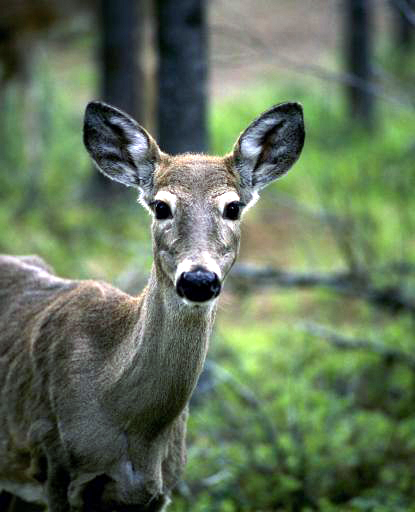 On Opening Day of rifle season, out in Giles County I had three does walk past me 30 yards off, totally oblivious to my blaze-orange-swaddled presence. I could have killed any one of them, but Giles wasn’t an either sex area at that time, damn it. Then, just as it was getting dark, another deer came in 40 yards off, headed for a scrape I’d staked out. While it was light enough to see it was a deer, and to know that I would have killed it if I’d fired, it was not light enough to see whether it had antlers. It was behaving like a buck: I’m 90% certain it was. But again, I had to pass it up. Three minutes later the woods were so dark I couldn’t see my rifle’s sights, and he/she/it had scampered off.
On Opening Day of rifle season, out in Giles County I had three does walk past me 30 yards off, totally oblivious to my blaze-orange-swaddled presence. I could have killed any one of them, but Giles wasn’t an either sex area at that time, damn it. Then, just as it was getting dark, another deer came in 40 yards off, headed for a scrape I’d staked out. While it was light enough to see it was a deer, and to know that I would have killed it if I’d fired, it was not light enough to see whether it had antlers. It was behaving like a buck: I’m 90% certain it was. But again, I had to pass it up. Three minutes later the woods were so dark I couldn’t see my rifle’s sights, and he/she/it had scampered off.
Two days later I went to a friend’s house in Montgomery County, which is an either-sex zone. He’d killed a doe in his front yard on Opening Day, and assured me, “They come out every day, I see them all the time. Just come and take your pick. There were five when I shot mine.” Needless to say—and this is always the case when someone says something like that—not a deer showed up all day.
So Wednesday afternoon, I hied myself up to Amherst with my friend and hunting partner Rick Fell, whose father Bill owns Three Oaks Farm, on which I have killed several deer over the past few seasons. Unfortunately I’m not the only one who hunts there. Two other deer had been killed there this season, so I had lowered my expectations somewhat; all the more so because I’d been skunked there on Opening Day of the eastern zone BP season. Worse yet, everyone in Amherst hates deer as much as I hate snakes. When a season opens, every deer that ventures out gets shot on sight. After three weeks of being shot at, all the dumb and unlucky ones would have been killed, and the smart ones would go nocturnal.
 Nor was the moon in my favor. It was full on the 24th; the entire time I’d be there the nights would be brilliantly lit. Bitter experience has shown me that under such conditions, deer start moving about dusk and bed up by 4:00 AM, hung over and exhausted from their carousing and wenching. By the time I got to a stand at 6:00, they’d all be snug in their beds, dreaming of the next night’s debauchery.
Nor was the moon in my favor. It was full on the 24th; the entire time I’d be there the nights would be brilliantly lit. Bitter experience has shown me that under such conditions, deer start moving about dusk and bed up by 4:00 AM, hung over and exhausted from their carousing and wenching. By the time I got to a stand at 6:00, they’d all be snug in their beds, dreaming of the next night’s debauchery.
Three Oaks Farm isn’t really a farm, it’s a 40-odd acre country property pretty much covered in white and red oak, with a liberal sprinkling of white pines planted as windbreak trees 40 years ago. Huff Creek runs along its west side, and an un-named tributary of Huff Creek on the east: the house, outbuildings, and a large field are situated in a flat meadow atop the steep hill between these two drainages.
On a property this small, there aren’t usually too many reliable and productive spots to sit, but there are always a few. My favorite spot is The Rock. I’ve killed 5 deer from The Rock, a flat piece of stone about the size of a kitchen table that sticks straight up out of the ground, providing me with a convenient backrest, a wind shadow, and a nice blind. It overlooks the confluence of several trails to and from Bill’s garden and compost heap. Deer typically come in from behind, making a fair amount of noise in the leaf litter, giving me plenty of warning. As they come around The Rock, by the time they’re in a position to see me…BANG! Quite often deer come out on the lawn in front of the main house at dawn and dusk—though not, of course, once the seasons have started—and a few years ago I shot one on the lawn as I came out of the guest house, heading up to the main house for dinner.
Another reliable location is Tony’s Spot, named for one of the other guys who hunts the farm. This is one genuinely scary place: a big oak sits perhaps three feet from edge of a 40-foot slope that has to be 75-80 degrees. The tree has a little concavity at the base, forming a natural “chair” overlooking a flat area on the bank of Huff Creek about where its tributary enters. Now, maybe Tony has no fear of heights, but I’m a little leery about sitting anyplace where a slip means a long drop to the bottom. Given that the ground is carpeted with slick oak leaves, a slip seems pretty likely.
I spent Wednesday evening and Thursday morning at The Rock, and never saw a thing, not even a squirrel. This was pretty amazing, since the farm has so many oaks that the Virginia State Squirrel Association holds its annual conventions there. But as everyone knows, there are times when all game seems to be scarce, and this past weekend seemed to be one of them. The woods were eerily quiet: not even many of the ubiquitous tweety-birds seemed to be around.
Came Friday morning, I was in a bit of a quandary, but I opted again for The Rock, hoping against hope. No dice. Nada. Friday afternoon I went to Tony’s Spot, where I spent an hour alternately watching the creek and wondering whether I was going to fall into into it. Then I pushed down into the bottom along the banks, again coming up with zero sightings, let alone a shot. Twelve hours in the woods on Friday with nothing to show for it at all.
 Saturday morning I almost didn’t get up. There’s an old proverb that “A warm bed and a warm woman have saved many a deer’s life,” and it’s true. As I age I find it’s not so easy to leap from bed at in the wee hours before dawn with a song on my lips and hope in my heart. Between the discouragement of not seeing anything for several days, and a fair level of fatigue from having awakened before the roosters for almost a week straight, it took a significant effort of will. But I had to leave to get back to Blacksburg and wanted to give it one more try.
Saturday morning I almost didn’t get up. There’s an old proverb that “A warm bed and a warm woman have saved many a deer’s life,” and it’s true. As I age I find it’s not so easy to leap from bed at in the wee hours before dawn with a song on my lips and hope in my heart. Between the discouragement of not seeing anything for several days, and a fair level of fatigue from having awakened before the roosters for almost a week straight, it took a significant effort of will. But I had to leave to get back to Blacksburg and wanted to give it one more try.
In the essay “First Shot Out Of The Box,” I described killing a squirrel with the first shot I ever fired from my Stevens Favorite. That spot was in my mind: last time I’d been there it looked very “deery.” It’s in a deep ravine below the road leading to Bill’s house: we see many deer on the road at night, so I reasoned that if they came in from feeding in the fields across the road, headed to a bedding area along the creek, they’d probably pass by me. The deer I’d lost during archery season had also run in that direction, another indication that it held some attraction for them. There’s very, very thick cover along the creek bank: if I were able to think like a deer I might well decide that it would make an ideal spot to bed up for the day.
So, after three stabs at the snooze alarm, I did actually manage to be on my stand by 6:00, at almost exactly the same spot where I’d killed the squirrel. Not much happened for a while, except that I did find out where all of Bill’s missing squirrels had gone. I must have seen ten of them between 6:00 and 7:00 AM. Things started happening at about 7:05, when I heard trot-trot-trot, and got ready. It was a false alarm, but not a squirrel: it was a red fox!
The chance of encountering a fox on his way home from an evening raiding chicken coops is one of the things that makes it worth getting out of bed so early. I like foxes. They remind me of little dogs; dapper and dainty animals with cute faces. Who cares if they’re black-hearted scoundrels who make their living raiding chicken houses? This fellow looked like a young ‘un, his color a sort of muddy yellow-red, not the blazing crimson I’ve seen from time to time. As he approached from 50-60 yards away, I thought at first he was a possum, but no, a it was indeed a fox.
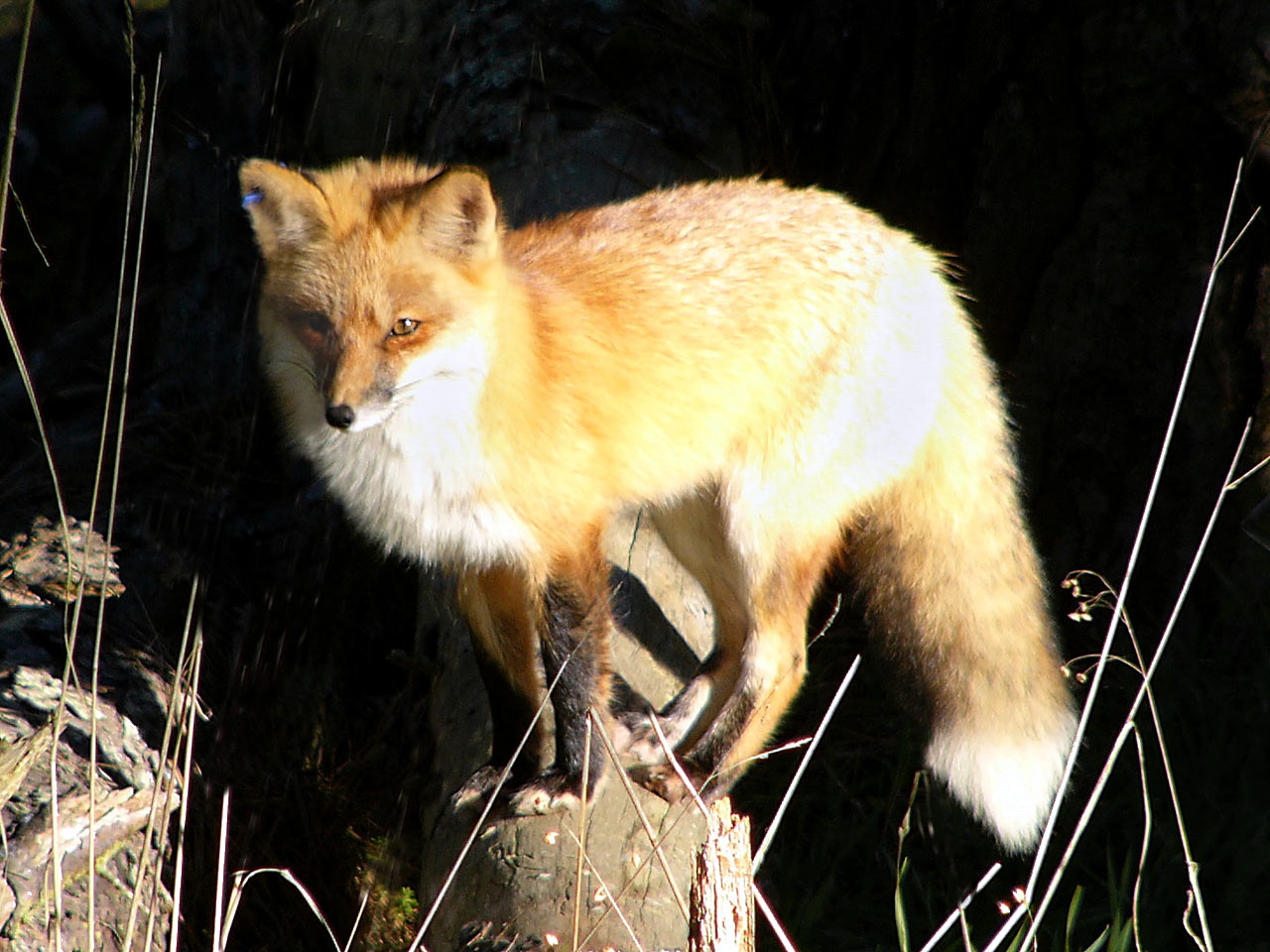 He was completely clueless about my presence, intent on getting to bed after a hard night’s work slaying the neighborhood White Leghorns and Rhode Island Reds. He trotted in completely at ease, following a straight line, passing me 5 feet away. At that point a very gentle zephyr blowing from my right gave him a whiff. He swapped ends and took off the way he’d come, again running straight as a taut string, really not in that much of a hurry. This sort of encounter with a fox has happened to me only three times in nearly four decades of hunting: it’s such a rarity that I couldn’t really consider it anything but a good omen.
He was completely clueless about my presence, intent on getting to bed after a hard night’s work slaying the neighborhood White Leghorns and Rhode Island Reds. He trotted in completely at ease, following a straight line, passing me 5 feet away. At that point a very gentle zephyr blowing from my right gave him a whiff. He swapped ends and took off the way he’d come, again running straight as a taut string, really not in that much of a hurry. This sort of encounter with a fox has happened to me only three times in nearly four decades of hunting: it’s such a rarity that I couldn’t really consider it anything but a good omen.
Now, I’m not superstitious. I don’t mind having a black cat cross my path, I think it’s absurd that office buildings have no 13th floor, and breaking a mirror has never caused me so much as a flutter of concern. But I do believe that it’s impossible for anyone who hunts not to be just a wee bit superstitious. Even the most skilled hunter and woodsman (which, I hasten to add, I most certainly am not) understands that luck has as much to do with success as skill does, always. When it comes to hunting I have to admit to a tiny bit of belief in the supernatural. That fox convinced me that my luck was about to change, things were going to go right that morning.
At 7:50, I spied a doe walking through the brush about 40 yards away, descending the steep embankment from the road to my left, headed to cross Huff Creek. She might have been headed for The Rock: she was moving in that direction, and at there was an active scrape and several rubs there. She might have had A Case Of The Hots for the buck who made that scrape and was headed there to be bred.
I watched her come along, settled on my shooting point, and when she reached it…I couldn’t fire because the lens on my scope had fogged up! Not fogged internally, thank goodness: it was misted over from my breath. I hurriedly wiped the glass with my thumb, while she kept steadily plodding along: by the time I got the lens clear, however, she’d moved away from the ideal point and was about to enter some brush where I’d not get a shot at all. I put the crosshairs on her and fired. At the shot she seemed to stagger a bit, but then continued trotting up the hill to the right, apparently not in much of a hurry and not really running, just moving a little bit faster than she’d been walking.
I was flabbergasted. I didn’t see how I could have missed her at that range, but damned if it didn’t look like a miss. I was also flustered because if it was a hit…well, no deer ever gets up and runs from that rifle. None. It has killed 15 animals with an unbroken succession of one-shot kills: 11 whitetails and four very large African antelope. That a 100-pound doe could take a hit from it at 40 yards and casually amble off was unthinkable, but I watched her climb the slope, making her way through the understory, apparently unconcerned. At the top of the ridge she stopped briefly, wagging her tail exactly like a dog, in the same “I’m happy” rhythm my Lab uses when she sees food. This was totally inexplicable. I let her go, watching as long as I could see her, then walked to the point where I saw her disappear into the scrub. She was not in sight, nor did I see any blood.
I walked all the way up the hill, shaking my head in dismay at this development and thinking that perhaps I had missed, maybe the bullet had been deflected. I walked up the ridge, then circled back around again to my shooting point; then walked to where she’d been when I fired. Then up the hill again along the route she’d followed, and as I did that I found the blood. She’d turned sharply to her left, away from me, after she’d been lost from my view. As I followed the blood trail I heard her kicking and thrashing 20-30 yards away, and saw her leg flailing in the air.
I headed for her, hoping she wouldn’t get up and run—had I hit her in the lower leg somehow? A deer can run for miles on three legs, and if that was the case I’d never catch her. Had she taken a non-mortal 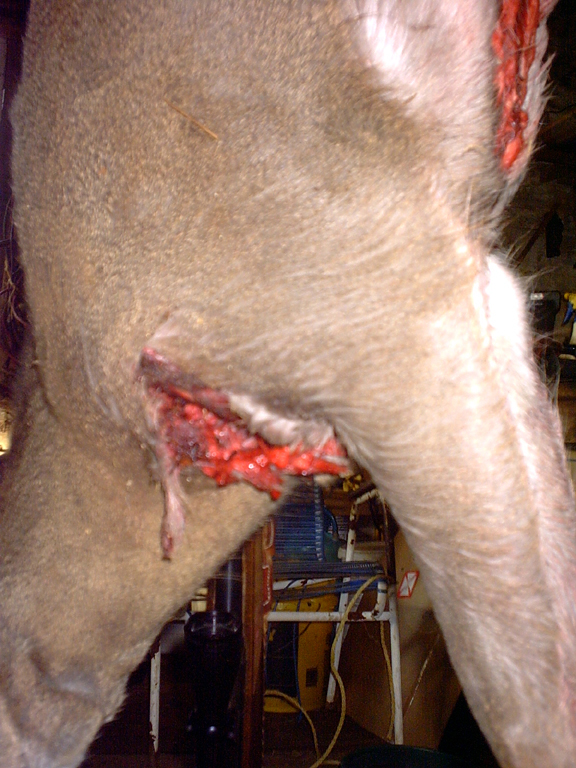 wound? But when I got to her there was blood and plenty of it: she was well down the slope into The Abyss, with perhaps 30 more seconds to live. I finished her off with my .380, ending things right then and there.
wound? But when I got to her there was blood and plenty of it: she was well down the slope into The Abyss, with perhaps 30 more seconds to live. I finished her off with my .380, ending things right then and there.
When I moved her to dress her out I saw the results of the shot and it explained much. I had aimed for a point just behind her right shoulder. Had the shot gone where I intended it would have shredded her lungs and anchored her instantly, but instead it had struck her 5”-6” forward of the shoulder joint. I have to check my sights: if they’re on then there must have been some bullet deflection.
There was a tiny entry hole in the right side, barely visible under the hair. The left shoulder was another story. It was pretty much all exit wound, a hole big enough to put my balled fist into. How she managed to survive even long enough to go the 100 yards she did is beyond me: another testimony to the toughness of whitetails. But there was no way she was going to live with a wound like that.
 Technical details: I used my trusty and much-loved Savage 110 in .30-06, the best $183 I ever spent on a rifle. I bought it at a going-out-of-business sale from a Roanoke discount store and it has never let me down. It’s one of those “From my cold, dead, hands!” guns. It’s fitted with a BSA 3-9X “Radiant” illuminated reticle scope. I’m not entirely satisfied with this scope. I used to use it on a .45-70 bolt gun, and with it made a couple of very clean kills, but I don’t much like variables. Every one I’ve owned has had a tendency to shift point of impact when you go up and down the range (I was using 3x). I cut my teeth on a fixed 4X Weaver many years ago. I think I’m going to grit my teeth and shell out for a fixed 4X Leupold and be done with it.
Technical details: I used my trusty and much-loved Savage 110 in .30-06, the best $183 I ever spent on a rifle. I bought it at a going-out-of-business sale from a Roanoke discount store and it has never let me down. It’s one of those “From my cold, dead, hands!” guns. It’s fitted with a BSA 3-9X “Radiant” illuminated reticle scope. I’m not entirely satisfied with this scope. I used to use it on a .45-70 bolt gun, and with it made a couple of very clean kills, but I don’t much like variables. Every one I’ve owned has had a tendency to shift point of impact when you go up and down the range (I was using 3x). I cut my teeth on a fixed 4X Weaver many years ago. I think I’m going to grit my teeth and shell out for a fixed 4X Leupold and be done with it.
I was using reloads I made up years ago: Remington’s 150-grain Core-Lokt bullet, over 49 grains of IMR 4895. This load duplicates the ballistics of the GI M-1 Ball load: I actually put it together for use in a Garand. I’ve killed deer with this load before, have a good deal of it on hand, and decided to use it up.
 The Core-Lokt bullet certainly is a swift killer, at least on whitetails, but it’s a bit violent if it hits bone, as happened here. Still, I’ve killed a pretty fair number of deer with it from both a .30-06 and a .30-30, and while it can mess them up, usually it doesn’t. On a through-the-chest lung and heart shot the Core-Lokt performs perfectly every time. Only once have I not had a complete pass through with it: a neck shot at point blank range that left the buck’s head looser than a bobble-head doll’s. The bullet broke up on the neck bones. So while the Core-Lokt is perhaps a little too fragile for bigger animals, it seems to be as good a bullet for whitetails as can be found.
The Core-Lokt bullet certainly is a swift killer, at least on whitetails, but it’s a bit violent if it hits bone, as happened here. Still, I’ve killed a pretty fair number of deer with it from both a .30-06 and a .30-30, and while it can mess them up, usually it doesn’t. On a through-the-chest lung and heart shot the Core-Lokt performs perfectly every time. Only once have I not had a complete pass through with it: a neck shot at point blank range that left the buck’s head looser than a bobble-head doll’s. The bullet broke up on the neck bones. So while the Core-Lokt is perhaps a little too fragile for bigger animals, it seems to be as good a bullet for whitetails as can be found.
 Last week I bought one of those “Butt Out” gadgets at Dick’s Sporting goods. You stick it into the deer’s anus, twist, and pull out the large intestine (which the instructions delicately call “the membrane”), tie it off and cut it. I found it a bit difficult to pull out the “membrane” but maybe with practice I’ll learn how to use it more effectively.
Last week I bought one of those “Butt Out” gadgets at Dick’s Sporting goods. You stick it into the deer’s anus, twist, and pull out the large intestine (which the instructions delicately call “the membrane”), tie it off and cut it. I found it a bit difficult to pull out the “membrane” but maybe with practice I’ll learn how to use it more effectively.
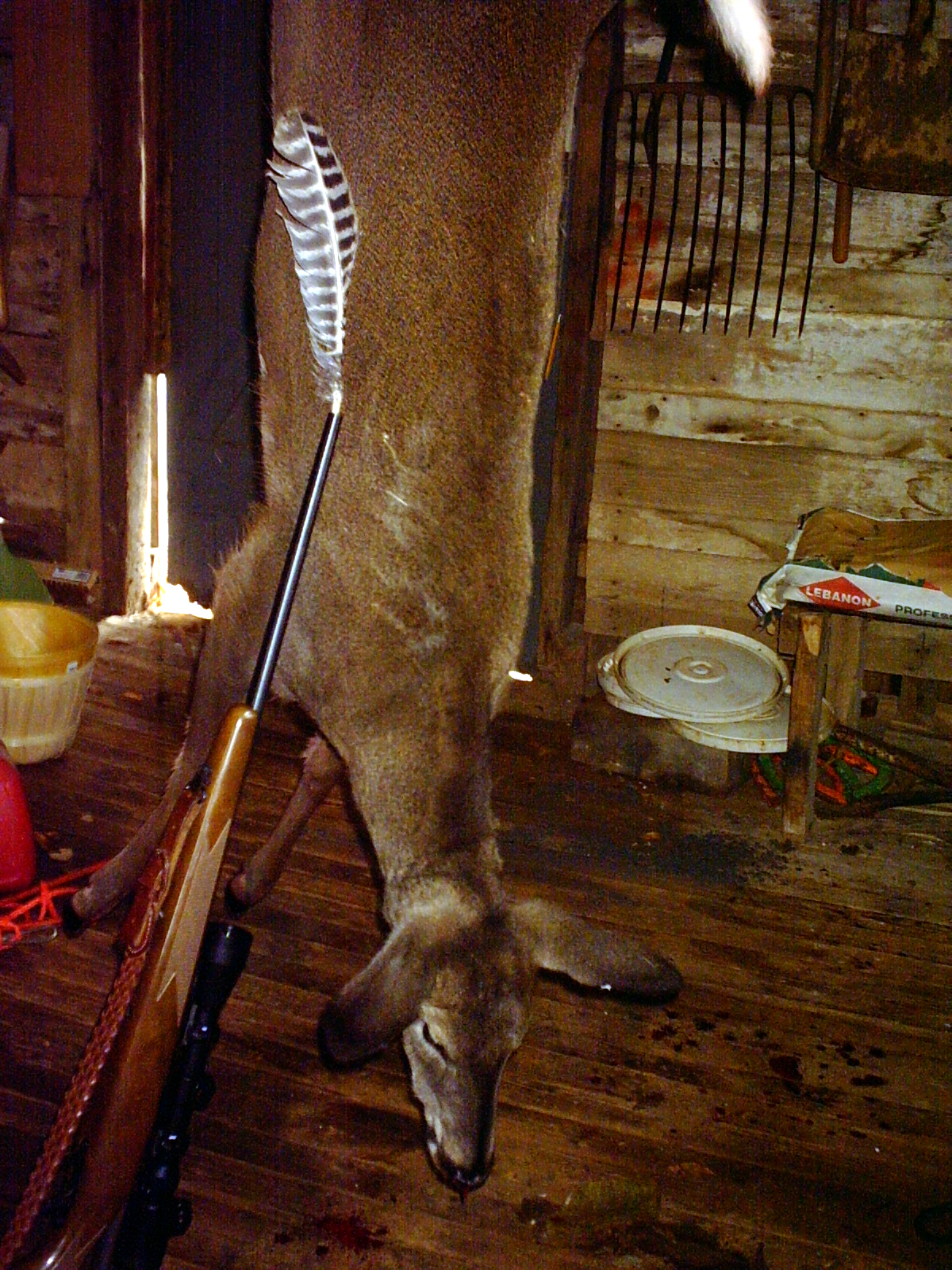 My wife is a wonderful woman, but she is entirely unreasonable about carrying dead deer in her Mazda MPV mini-van. So the doe stayed in Amherst for Rick to bring back in his truck. His wife was upset that he’d be transporting the deer in his truck without skinning it. She said she “…didn’t want to see it,” to which my (and Rick’s) reply was “Then don’t look out the rear window, and ignore her if she gets up and taps on the glass.” You would think the deer was going to be in the cab with them and the dog, for Pete’s sake. Speaking of Rick’s dog, she got into the gut pile. He and his wife had to spend two hours in a truck cab with a yellow Lab churning out deer-gut-driven farts….I bet that was fun! Sam won the Dog Olympics
My wife is a wonderful woman, but she is entirely unreasonable about carrying dead deer in her Mazda MPV mini-van. So the doe stayed in Amherst for Rick to bring back in his truck. His wife was upset that he’d be transporting the deer in his truck without skinning it. She said she “…didn’t want to see it,” to which my (and Rick’s) reply was “Then don’t look out the rear window, and ignore her if she gets up and taps on the glass.” You would think the deer was going to be in the cab with them and the dog, for Pete’s sake. Speaking of Rick’s dog, she got into the gut pile. He and his wife had to spend two hours in a truck cab with a yellow Lab churning out deer-gut-driven farts….I bet that was fun! Sam won the Dog Olympics 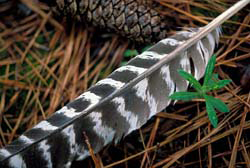 Farting Silver Medal two years ago. Deer Guts: The Breakfast Of Champions.
Farting Silver Medal two years ago. Deer Guts: The Breakfast Of Champions.
I have the habit of “naming” kills so I can remember them individually. As this doe lay dead, next to the spot where she’d fallen were half a dozen wild turkey feathers. These will serve as her memento mori, and she will always be The Turkey-Feather Doe in my memories of this hunt.
| HUNTING | GUNS | DOGS |
| FISHING & BOATING | TRIP REPORTS | MISCELLANEOUS ESSAYS |
| CONTRIBUTIONS FROM OTHER WRITERS|
| RECIPES |POLITICS |